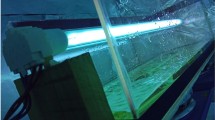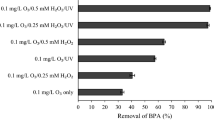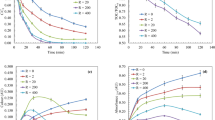Abstract
A theoretical and experimental study of bisphenol A (BPA) degradation by the UV/H2O2 process in water is presented. The effects of the H2O2 concentration and the specific rate of photon emission (EP,0) on BPA degradation were investigated. A kinetic model derived from a reaction sequence was employed to predict BPA and hydrogen peroxide concentrations over time using an annular photochemical reactor in batch recirculation mode. The local volumetric rate of photon absorption (LVRPA) inside the photoreactor was computed using a Line Source with Parallel Plane emission model (LSPP). From the proposed kinetic model and the experimental data, the second order rate constants of the reactions between hydroxyl radicals and the main reacting species (H2O2 and BPA) were estimated applying a nonlinear regression method. A good agreement between the kinetic model and experimental data, for a wide range of operating conditions, was obtained. For BPA, H2O2, and TOC concentrations, the calculated root means square errors (RMSE) were 2.3 × 10− 2, 9.8 × 10− 1, and 9.0 × 10− 2 mmol L− 1, respectively. The simplified kinetic model presented in this work can be directly applied to scaling-up and reactor design, since the estimated kinetic constants are independent of the reactor size, shape, and configuration. Further experiments were made by employing low BPA initial concentration (100 μg L− 1) in water and real wastewater. A lower degradation rate of BPA was observed in the real wastewater, although the UV/H2O2 process has also been able to completely degrade the target pollutant in less than 1 h.




Similar content being viewed by others
References
Alfano OM, Romero RL, Cassano AE (1986) Radiation field modelling in photoreactors-I. Homogeneous media Chem Eng Sci 41:421–444. https://doi.org/10.1016/0009-2509(86)87025-7
Alfano OM, Brandi RJ, Cassano AE (2001) Degradation kinetics of 2,4-D in water employing hydrogen peroxide and UV radiation. Chem Eng J 82:209–218. https://doi.org/10.1016/S1385-8947(00)00358-2
Beltrán FJ, Aguinaco A, García-Araya JF (2010) Kinetic modelling of TOC removal in the photocatalytic ozonation of diclofenac aqueous solutions. Appl Catal B-Environ 100:289–298. https://doi.org/10.1016/j.apcatb.2010.08.005
Braun AM, Maurette MT, Oliveros E (1991) Photochemical technology. John Wiley & Son Ltd, New Jersey
Chen PJ, Linden KG, Hinton DE, Kashiwada S, Rosenfeldt EJ, Kullman SW (2006) Biological assessment of bisphenol A degradation in water following direct photolysis and UV advanced oxidation. Chemosphere. https://doi.org/10.1016/j.chemosphere.2006.04.048
Chen PJ, Rosenfeldt EJ, Kullman SW, Hinton DE, Linden KG (2007) Biological assessments of a mixture of endocrine disruptors at environmentally relevant concentrations in water following UV/H2O2 oxidation. Sci Total Environ 376:18–26. https://doi.org/10.1016/j.scitotenv.2006.12.051
Conte LO, Farias J, Albizzati ED, Alfano OM (2012) Photo-Fenton degradation of the herbicide 2,4-dichlorophenoxyacetic acid in laboratory and solar pilot-plant reactors. Ind Eng Chem Res 51:4181–4191. https://doi.org/10.1021/ie2023228
Contreras S, Rodríguez M, Al Momani F, Sans C, Esplugas S (2003) Contribution of the ozonation pre-treatment to the biodegradation of aqueous solutions of 2,4-dichlorophenol. Water Res 37:3164–3171. https://doi.org/10.1016/S0043-1354(03)00167-2
Crittenden JC, Hu S, Hand DW, Green SA (1999) A kinetic model for H2O2/UV process in a completely mixed batch reactor. Water Res 33:2315–2328. https://doi.org/10.1016/S0043-1354(98)00448-5
Edalatmanesh M, Dhib R, Mehrvar M (2008) Kinetic modeling of aqueous phenol degradation by UV/H2O2 process. Int J Chem Kinet 40:34–43. https://doi.org/10.1002/kin.20286
Felis E, Ledakowicz S, Miller JS (2011) Degradation of bisphenol a using UV and UV/H2O2 processes. Water Environ Res 83:2154–2158. https://doi.org/10.2175/106143011X12989211841214
Goulart de Araujo L, Santos F da S, Teixeira ACSC (2017) Degradation of bisphenol A by the UV and UV/H2O2 processes: evaluation of process variables through experimental design. Can J Chem Eng 95:2278–2285. https://doi.org/10.1002/cjce.22997
Huang CR, Shu HY (1995) The reaction kinetics, decomposition pathways and intermediate formations of phenol in ozonation, UV/O3 and UV/H2O2 processes. J Hazard Mater 41:47–64. https://doi.org/10.1016/0304-3894(94)00093-V
Im J, Löffler FE (2016) Fate of bisphenol A in terrestrial and aquatic environments. Environ Sci Technol 50:8403–8416. https://doi.org/10.1021/acs.est.6b00877
Jamil TS, Roland H, Michael H, Jens-Uwe R (2017) Homogeneous photocatalytic processes for degradation of some endocrine disturbing chemicals under UV irradiation. J Water Process Eng 18:159–168. https://doi.org/10.1016/j.jwpe.2017.04.005
Kusvuran E, Yildirim D (2013) Degradation of bisphenol A by ozonation and determination of degradation intermediates by gas chromatography-mass spectrometry and liquid chromatography-mass spectrometry. Chem Eng J 220:6–14. https://doi.org/10.1016/j.cej.2013.01.064
Lastre-Acosta AM, Barberato B, Parizi MPS, Teixeira ACSC (2019) Direct and indirect photolysis of the antibiotic enoxacin: Kinetics of oxidation by reactive photo-induced species and simulations. Environ Sci Pollut Sci 4337-4347. https://doi.org/10.1007/s11356-018-2555-4
Li Puma G, Puddu V, Tsang HK, Gora A, Toepfer B (2010) Photocatalytic oxidation of multicomponent mixtures of estrogens (estrone (E1), 17β-estradiol (E2), 17α-ethynylestradiol (EE2) and estriol (E3)) under UVA and UVC radiation: Photon absorption, quantum yields and rate constants independent of photon absorption. Appl Catal B Environ 99:388–397. https://doi.org/10.1016/j.apcatb.2010.05.015
Li YM, Zeng QL, Yang SJ (2011) Removal and fate of estrogens in an anaerobic-anoxic-oxic activated sludge system. Water Sci Technol 63:51–56. https://doi.org/10.2166/wst.2011.008
M. C. Group (2013) World BPA production grew by over 372,000 tonnes in 2012. http://mcgroup.co.uk/news/20131108/bpa-production-grew-372000-tonnes.html.
Mohajerani M, Mehrvar M, Ein-mozaffari F (2012) Computational fluid dynamics (CFD) modeling of photochemical reactors. Appl Comput Fluid Dyn:155–176. https://doi.org/10.1016/j.memsci.2005.11.013
Mohapatra DP, Brar SK, Tyagi RD, Surampalli RY (2011) Concomitant degradation of bisphenol A during ultrasonication and Fenton oxidation and production of biofertilizer from wastewater sludge. Ultrason Sonochem 18:1018–1027. https://doi.org/10.1016/j.ultsonch.2011.03.013
Nakashima T, Ohko Y, Kubota Y, Fujishima A (2003) Photocatalytic decomposition of estrogens in aquatic environment by reciprocating immersion of TiO2-modified polytetrafluoroethylene mesh sheets. J Photochem Photobiol A Chem 160:115–120. https://doi.org/10.1016/S1010-6030(03)00229-6
Oppenländer T (2003) Photochemical purification of water and air: advanced oxidation processes (AOPs) -principles, reaction mechanisms, Reactor Concepts. John Wiley & Sons
Pignatello JJ, Oliveros E, MacKay A (2006) Advanced oxidation processes for organic contaminant destruction based on the Fenton reaction and related chemistry. Crit Rev Environ Sci Technol 36:1–84. https://doi.org/10.1080/10643380500326564
Rahim Pouran S, Abdul Aziz AR, Wan Daud WMA (2015) Review on the main advances in photo-Fenton oxidation system for recalcitrant wastewaters. J Ind Eng Chem 21:53–69. https://doi.org/10.1016/j.jiec.2014.05.005
Rosenfeldt EJ, Linden KG (2004) Degradation of endocrine disrupting chemicals bisphenol A, ethinyl estradiol, and estradiol during UV photolysis and advanced oxidation processes. Environ Sci Technol 38:5476–5483. https://doi.org/10.1021/es035413p
Sharma J, Mishra IM, Kumar V (2015) Degradation and mineralization of bisphenol A (BPA) in aqueous solution using advanced oxidation processes: UV/H2O2 and UV/S2O82− oxidation systems. J Environ Manag 156:266–275. https://doi.org/10.1016/j.jenvman.2015.03.048
Simunovic M, Kusic H, Koprivanac N, Bozic AL (2011) Treatment of simulated industrial wastewater by photo-Fenton process: part II. The development of mechanistic model. Chem Eng J 173:280–289. https://doi.org/10.1016/j.cej.2010.09.030
Staehelln J, Hoigne J (1985) Decomposition of ozone in water in the presence of organic solutes acting as promoters and inhibitors of radical chain reactions. Environ Sci Technol 19:1206–1213. https://doi.org/10.1021/es00142a012
Staples CA, Dome PB, Klecka GM, Oblock ST, Harris LR (1998) A review of the environmental fate, effects, and exposures of bisphenol A. Chemosphere 36:2149–2173. https://doi.org/10.1016/S0045-6535(97)10133-3
Tijani JO, Fatoba OO, Petrik LF (2013) A review of pharmaceuticals and endocrine-disrupting compounds: sources, effects, removal, and detections. Water Air Soil Pollut 224:1770–1770. https://doi.org/10.1007/s11270-013-1770-3
Vedrenne M, Vasquez-Medrano R, Prato-Garcia D, Frontana-Uribe BA, Hernandez-Esparza M, de Andrés JM (2012) A ferrous oxalate mediated photo-Fenton system: Toward an increased biodegradability of indigo dyed wastewaters. J Hazard Mater 243:292–301. https://doi.org/10.1016/j.jhazmat.2012.10.032
Wei X, Huang Y, Wong MH, Giesy JP, Wong CK (2011) Assessment of risk to humans of bisphenol A in marine and freshwater fish from Pearl River Delta, China. Chemosphere 85:122–128. https://doi.org/10.1016/j.chemosphere.2011.05.038
Zhang Y, Zhou JL, Ning B (2007) Photodegradation of estrone and 17β-estradiol in water. Water Res 41:19–26. https://doi.org/10.1016/j.watres.2006.09.020
Acknowledgments
We are also thankful to Dr. José Eduardo Graciano (Department of Chemical Engineering, University of São Paulo, Brazil) for his valuable help with Matlab® and model discussion.
Funding
This study was financed in part by the Coordenação de Aperfeiçoamento de Pessoal de Nível Superior – Brasil (CAPES) – Finance Code 001. The authors also thank the Consejo Nacional de Investigaciones Científicas y Técnicas (CONICET), Agencia Nacional de Promoción Científica y Tecnológica (ANPCyT), and Universidad Nacional del Litoral (UNL, Argentina) for the financial support.
Author information
Authors and Affiliations
Corresponding author
Ethics declarations
Conflict of interest
The authors declare that they have no conflicts of interest.
Additional information
Responsible editor: Vítor Pais Vilar
Publisher’s note
Springer Nature remains neutral with regard to jurisdictional claims in published maps and institutional affiliations.
Electronic supplementary material
ESM 1
(DOCX 88.2 kb)
Rights and permissions
About this article
Cite this article
de Araujo, L.G., Oscar Conte, L., Violeta Schenone, A. et al. Degradation of bisphenol A by the UV/H2O2 process: a kinetic study. Environ Sci Pollut Res 27, 7299–7308 (2020). https://doi.org/10.1007/s11356-019-07361-7
Received:
Accepted:
Published:
Issue Date:
DOI: https://doi.org/10.1007/s11356-019-07361-7




